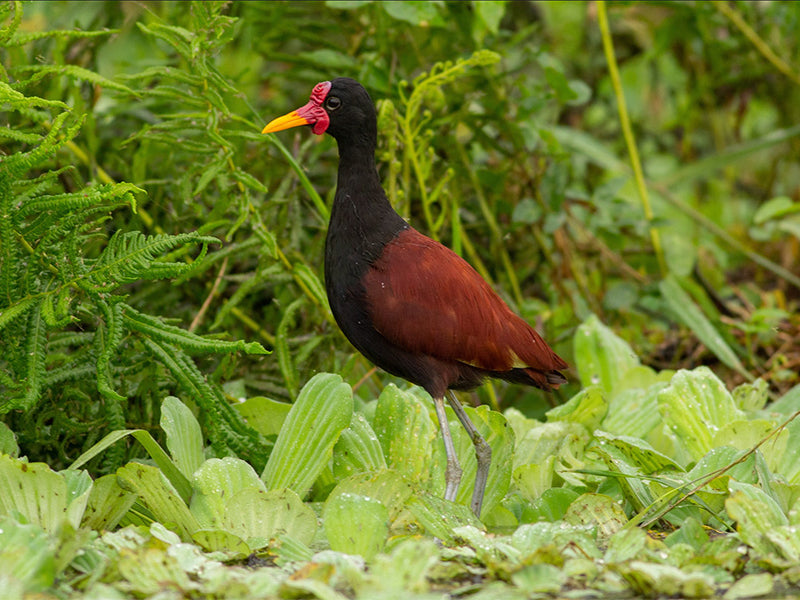Jacanas
| Order: CHARADRIIFORMES - Family: JACANIDAE |
| 8 Species currently existing - 1 in region |
Jacanas are a group of tropical wading birds that are known for their striking appearance and interesting behaviors. Here are some key points about jacanas: Read in Spanish
Physical Description: Jacanas are characterized by their long legs and toes, which enable them to walk on floating vegetation and navigate through aquatic vegetation in search of food. They have distinctive coloration, with bright plumage in shades of blue, green, yellow, and black.
Habitat: Jacanas are typically found in freshwater wetlands, marshes, ponds, and shallow lakes in tropical and subtropical regions of the world. They are often associated with dense vegetation, where they can forage for invertebrates and small aquatic creatures.
Diet: Jacanas are omnivorous birds that feed on a variety of foods, including insects, small fish, crustaceans, seeds, and aquatic plants. Their long toes and claws help them walk on floating vegetation to access their prey.
Behavior: Jacanas are known for their unique breeding system, where females are larger and more brightly colored than males. Males are responsible for building nests, incubating the eggs, and caring for the young, while females defend territories and seek out additional mates.
Reproduction: Jacanas are monogamous or polyandrous, meaning females may mate with multiple males who then raise the offspring. This unusual breeding strategy is thought to be an adaptation to their wetland habitat, where resources are patchy and unpredictable.
Vocalization: Jacanas have a variety of calls and vocalizations, including whistles, trills, and alarm calls. These vocalizations are used for communication between mates, to defend territories, and to warn of potential threats.
Conservation: Some species of jacanas are facing threats such as habitat loss, wetland degradation, and pollution. Conservation efforts are focused on protecting their wetland habitats, raising awareness about the importance of these ecosystems, and monitoring populations to ensure their long-term survival.
Jacanas are fascinating birds with unique adaptations for life in wetland habitats. Their colorful plumage, specialized foraging behaviors, and intricate breeding systems make them both visually captivating and scientifically intriguing.

Wattled Jacana
Jacana jacana
Spanish Name: Gallito-de-ciénega
Size: 9 in | 23 cm
Habitat: Aquatic vegetation, marshes, rice fields.
Height: <1400 m
Photo:© Luis A. Materon

Black-backed Jacana
Jacana (jacana) hypomelaena
Spanish Name: Gallito-de-ciénega
Size: 9 in | 23 cm
Habitat: Aquatic vegetation, marshes, rice fields.
Height: <1400 m
Photo:© David Monroy Rengifo eBird S61989484 Macaulay Library ML194403731

Chestnut-backed Jacana
Jacana (jacana) jacana
Spanish Name: Gallito-de-ciénega
Size: 9 in | 23 cm
Habitat: Aquatic vegetation, marshes, rice fields.
Height: <1400 m
Photo:© Andrew Spencer eBird lista S46546318 Macaulay Library ML140258401

